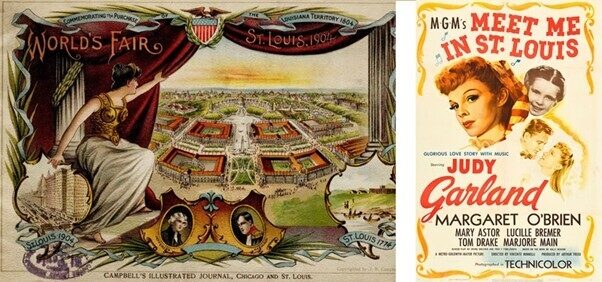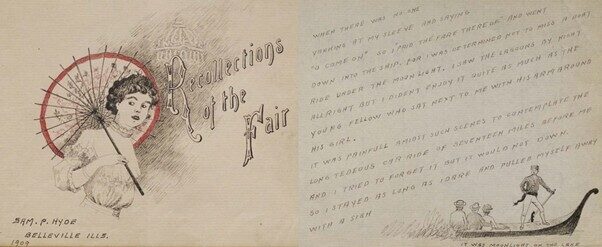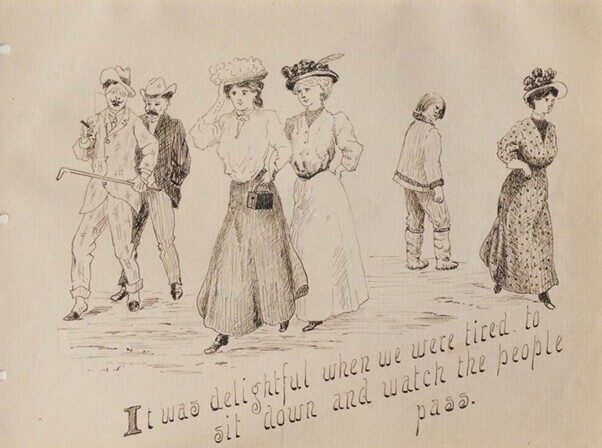Meet me at the fair: a Christmas controversy
At AM, the annual debate over what constitutes a Christmas film has been raging. Does it have to be Christmas throughout the narrative? Does Christmas have to be integral to the plot? Does Die Hard count? Vincente Minnelli’s 1944 musical Meet Me in St Louis is a personal favourite, but one that I have struggled to convince my Editorial colleagues is a bone fide Christmas classic, taking place as it does throughout a whole year, but featuring Judy Garland’s iconic and undeniable rendition of ‘Have Yourself a Merry Little Christmas.’

Left-hand image © St. Louis Mercantile Library at the University of Missouri - St. Louis. Further reproduction without permission is prohibited. Right-hand image: public doman via WikiMedia Commons https://commons.wikimedia.org/wiki/File:Meet_Me_in_St._Louis_poster.jpg
Following the Smith family, their lives and loves from 1903-1904, rather than Christmas, the denouement has the characters meeting at the historic St Louis 1904 World's Fair. The film ends with one of the most famous elements of this exhibition, the (festive) illuminations, being turned on to the amazement of the family: "There's never been anything like it in the whole world!"

Image © Missouri Historical Society. Further reproduction without permission is prohibited
AM's World's Fair: A Global History of Expositions includes a wealth of documents relating to the 1904 St Louis Louisiana Purchase Exhibition, which offer a fascinating opportunity to delve into real visitors' responses. Key among these are diaries of local people like the Philibert family who recorded details of 28 separate visits to the exposition. The illuminations are noted as particularly impressive: "as the lights were turned on for the first time the people raised a hearty cheer, for it was a grand sight indeed". Sam P. Hyde's unusual diary includes observations, photographs and illustrations, and describes "many an hour I sat watching these lights, as one who hates to be awakened from a pleasant dream".

Image © Missouri Historical Society. Further reproduction without permission is prohibited
Common features the diarists describe include the costs of admission to the fair and its various buildings (extra for the baby incubator and camel rides), descriptions of the products and manufacturing exhibits from around the world as well as art and entertainment displays.
The 1904 fair was a celebration of America’s acquisition of the territory of Louisiana in 1803. With a theme based on national expansion, it is unsurprising that it had strong imperialist tones and celebrated white American achievement and colonization. This is clearly reflected in the diaries (iced tea in the East India Building anyone?), and Philibert describes parades of peoples from different countries and an ‘Indian Reservation’ exhibition that featured Apache leader Geronimo.
There were controversies for the contemporary commentators as well, as Hyde criticises hundred-year-old trees being felled to clear the ground before building the fair. Meet Me in St Louis may bypass these intricacies with the same light touch that it gives to the Smith’s brief Christmas scene, but with its family-focused message, spectacular Technicolor treatment and of course that Christmas song, to me it’s is a no brainer. As is Die Hard, by the way.
As well as diaries and photographs, World's Fairs: A Global History of Expositions contains oral histories, scrapbooks, posters, catalogues, organisational records and much more relating to the 1904 St Louis exposition and hundreds of other fairs around the world.
Recent posts

The blog highlights American Committee on Africa, module II's rich documentation of anti-apartheid activism, focusing on the National Peace Accord, global solidarity, and student-led divestment campaigns. It explores the pivotal role of universities, protests, and public education in pressuring institutions to divest from apartheid, shaping global attitudes toward social justice and reform.

This blog examines how primary sources can be used to trace the impact of young voices on society, particularly during pivotal voting reforms in the UK and the US. Explore materials that reveal insights into youth activism, intergenerational gaps, and societal perceptions, highlighting their interdisciplinary value for studying youth culture, activism, and girlhood across history.
